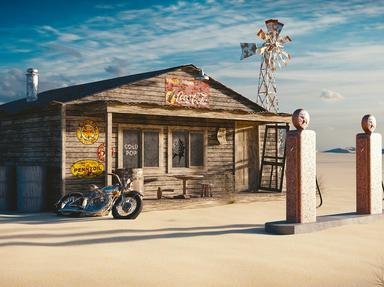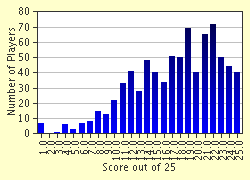Quiz Answer Key and Fun Facts
1. "Oh, the shark, babe, has such teeth, dear
And it shows them pearly white"
What was the number one song of 1959? It has become a genuine classic.
2. Here's a sample of the lyric from the number two ranked song from 1959. What city is highlighted in the title?
"Yeah they ran through the briars and they ran through the brambles
And they ran through the bushes where a rabbit couldn't go
They ran so fast that the hounds couldn't catch 'em
On down the Mississippi to the Gulf of Mexico"
3. "Venus, if you do
I promise that I always will be true
I'll give her all the love I have to give
As long as we both shall live"
Your lyrical clue from the third highest ranked song of 1959 with 1403.72 points, the title is probably fairly apparent. But which teenage idol had the girls swooning whenever he sang it?
4. The fourth ranked song of 1959 was recorded by The Platters and had a three-week run at number one on the Billboard Hot 100. Here's a bit of the lyric, you name the song!
"They asked me how I knew my true love was true
I of course replied 'something here inside cannot be denied'"
5. Ranked at number five for 1959 was this song by Ritchie Valens. Unfortunately, he was among the victims of the tragic plane crash that also claimed the lives of Buddy Holly and the Big Bopper. This song was peaking at number two on the charts at about the time of his death. Here's a piece of the lyric:
"Now that you're gone I'm left all alone
All by myself to wander and roam 'cause I love my girl"
What was the name of the girl who left Ritchie moaning? It is also the song's title.
6. The Fleetwoods, a white trio specializing in doo-wop ballads, recorded the sixth ranked hit of 1959. The song was about "Mr. ______". Fill in the blank to complete the title.
7. The song ranked number seven in 1959 was recorded by Lloyd Price and tells the story of Billy and our protagonist whose name was the title of the song. In one version, this character shoots and kills Billy after a dispute during a craps game. In another version specially recorded for Price's appearance on "American Bandstand", Billy steals the protagonist's girl but surrenders her back to save their friendship. What song was this?
8. The eighth ranked song for 1959 with 1292.06 points is represented by these lyrics:
"Somebody, somebody, somebody, please send her to me
I'll make her happy, just wait and see
I prayed so hard to the heavens above
That I might find someone to love"
What was that song?
9. Ranked number nine for 1959 was a recording by Guy Mitchell. Poor Guy is having cardiac issues. Which of the following statements best describes his problem?
10. The tenth-ranked hit of 1959 was a song by The Browns which told the story, a very compressed one, of a fellow who was born, got married and died, all in his little village. The constant was "The Three Bells" which rang to mark each event. The lyrics mention the fellow's name throughout. Do you know it?
11. "Oh, tell me where the answer lies
Is it in her kiss or in her eyes?"
Our question is... what sort of question or questions is Clyde McPhatter asking as exemplified in these lyrics?
12. "Don't believe all those lies
Darlin' just believe your eyes and look, look"
This is your lyrical clue to the number 12-ranked recording of 1959. The artist is the now long forgotten Carl Dobkins, Jr. Can you identify the title?
13. "People say that love's a game
A game you just can't win
If there's a way I'll find it someday
And then this fool will rush in"
This lyrical sample is from a number two-charted song in 1959 that garnered enough points to slip into the number 13 spot in the year-end rankings. I will give you a song title and the artist that performed it... you match them up to this lyric - but be careful!
14. Sitting at number 14 for the year of 1959 was another Fleetwoods number. It was their first hit of the year and sat atop the charts for four weeks. The following is about the only piece of the lyric that I can provide that's meaningful while at the same time, doesn't give the answer away.
"Speak softly, darling
Hear what I say
I love you always
Always, always"
15. "Over and over, I tried to prove my love to you
Over and over, what more can I do
Over and over, my friends say I´m a fool
But over and over, I´ll be a fool for you"
These lyrics are from Lloyd Price's second big hit from 1959. It wasn't a number one hit but it did spend three weeks at number two and with 19 weeks in the Hot 100, enough to gather 1173.39 points, it slots in at number 15 for the year. Can you name it?
16. "__________, life's a holiday on ___________
Just a holiday on __________, with you"
Jerry Wallace recorded this number eight hit in 1959 that had a long enough run in the Hot 100 to ultimately rate as the number 25 song for 1959. I know it's tough, despite its high ranking, but it was just too pleasant a song to overlook in this recap! The blanks represent a place where he would take his favorite gal.
17. During this era there were several charting songs about U.S. cities and one of them was number one for two weeks in 1959 and finished the year as the 27th ranked song for the year. The singer was hanging out on the corner of 12th St. and Vine of which metropolis?
18. In 1959, Brook Benton barged onto the scene with one of his biggest hits, a number three chart success that eventually ranked number 31 for the entire year. Careful study of this lyric segment should suggest the right answer.
"After I gave you everything I had
You laughed and called me a clown
Remember, in your search for fortune and fame
What goes up must come down
I know, I know that one day you'll wake up and find
That my love was a true love"
19. Although the following song never even entered the top 10, it peaked at number 11, it did hang around for 15 weeks in the top 40 earning enough points to rank number 35 for the year. Here's how it starts:
"This is the moment I've waited for
I can hear my heart singing
Soon bells will be ringing"
What was the title?
20. "I cried a tear for nobody but you
I'll be a lonely one if you should say we're through
Well, if you want to make me cry that won't be so hard to do
And if you should say goodbye I'll still go on loving you
Each night I ask the stars up above"
What was that question asked to the stars in this song from 1959? It peaked at number 5 on the Billboard charts and finished up the year ranked in the 50th slot.
21. Instrumentals were still staples of the Hot 100 in 1959. Among the biggest that year were the following records and their year end ranking: "Sleep Walk" by Santo & Johnny - 17; "The Happy Organ" by Dave Cortez - 26; "In The Mood" by Ernie Fields - 30; and, "Teen Beat" by Sandy Nelson - 38. At number 56 was a TV theme that was one of the stepping-stones for composer Henry Mancini leading to an incredible career as a composer, arranger and conductor, primarily for the screen. The song was brassy, jazzy, sultry, loud and evocative! Performed by Ray Anthony, what was that TV theme?
22. Sixteen year old Fabian had a big year in 1959 with six hits charting in the Hot 100. His biggest was a number three hit that concluded the year ranked number 65. Here's the first stanza:
"Hey lumpa sugar you look kinda sweet
Cuter than a baby walkin' down the street
When I look into your eyes, I wanna leap
I can't conceal that you make me feel
Like a ______"
What animal does Fabian feel like?
23. One of the top TV shows of the day was "77 Sunset Strip". Edd Byrnes co-starred as Kookie, the car valet. Connie Stevens, played Cricket Blake on "Hawaiian Eye" as a nightclub singer, and on occasion, she would make a guest appearance on Byrnes' show since both were produced by the same company. Together they sung a song in 1959 that charted at number four and ranked number 70 for the year. The title was "Kookie, Kookie (Lend Me Your ______). If you remember the show this is a gimmie but what was Connie asking Edd to lend her?
24. The song ranked number 92 for the year was "The Battle Hymn Of The Republic". Who recorded this unlikely hit?
25. "This old man he played one
He played nick nack on my drum
With a nick nack taddy whack
Give a dog a bone
This old man came rolling home"
Bet you either forgot or didn't know that this kiddie's ditty was a chart performer in 1959? Well, it was, but do you know what the song's title was? (Parenthetical parts of the title are disregarded for the purposes of this quiz question).
Source: Author
maddogrick16
This quiz was reviewed by FunTrivia editor
agony before going online.
Any errors found in FunTrivia content are routinely corrected through our feedback system.

